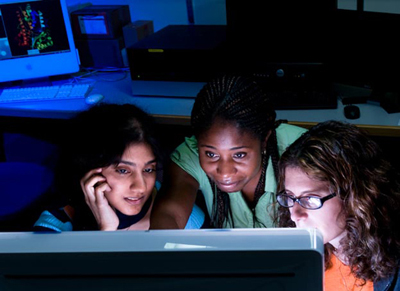Structural Biology and Biophysics
The Structural Biology and Biophysics cluster provides graduate training in this exciting and important area for biomedical research that draws upon concepts and approaches from biology, chemistry, physics, and mathematics. Students gain fluency in the ‘languages’ of the underlying disciplines and learn to frame biological questions and also to develop and/or deploy multidisciplinary tools to answer these questions.
The cluster features a vibrant group of more than two dozen accomplished and highly collaborative faculty with diverse research interests in structural biology, drug design, mechanistic biology, computational biology and informatics, and chemical biology. A variety of biological questions exploring molecular phenomena that impact gene transcription, translation, metal trafficking and homeostasis, electron transfer, mitochondrial positioning, viral fusion, chromosome structure, DNA-centric processes, RNA maturation, proteostasis, transport processes within the cell and across cell membranes, metabolic networks, and cellular signaling are being studied using physical approaches and/or principles. Northwestern University provides outstanding research resources including state-of-the-art instrumentation and fully staffed facilities for students aspiring to do cutting-edge research in these areas.
Besides providing a highly interactive and interdisciplinary research environment, student trainees share a common learning experience through didactic coursework at the introductory and advanced levels on contemporary structural biology and biophysics (see below); The cluster sponsors a variety of extra-didactic enrichment activities for students including biweekly biophysics seminars and monthly journal clubs that highlight exciting recent developments in this area. These events provide numerous opportunities for students to develop oral presentation skills and receive feedback on their research projects.
Information on the NIH funded Molecular Biophysics Training Grant (T32) can be found here.
Graduate-level Courses Developed by Cluster Faculty
- Molecular Biophysics (IBiS 401)
- Macromolecular Structure and Function (DGP 465)
- Structural Basis of Signal Transduction (DGP 466)
- Biophysical Methods for Macromolecular Analysis (IBiS 409)
- Quantitative Biology (IBiS 410)
- Structural Biology Workshop
Cluster Co-directors
- Ishwar Radhakrishnan, PhD Professor, Molecular Biosciences
- Amy Rosenzweig, PhD Professor, Molecular Biosciences/Chemistry
Training Faculty
- Jason Brickner, PhD (IBiS) Regulation of Gene Positioning in the Nucleus and their Effects on Expression
- Kyle Eagen, PhD (DGP) Structural and biochemical basis of chromatin folding and chromosome condensation
- Douglas Freymann, PhD (DGP) Structural Biology, X-ray Crystallography, Macromolecular Structure/Function- GTPase mechanism, Signal Recognition Particle (SRP) targeting complex, and Mitochondrial protein Miro, among others
- Xiaolin He, PhD (DGP) Structural Cancer Biology and Neurobiology; Cell-surface Receptors in Development and Cancer
- Yuan He, PhD (IBiS) Structure and function of macromolecular machines on genes; single particle cryo electron microscopy
- Brian Hoffman, PhD (IBiS) Interprotein electron transfer, ENDOR of metalloenzymes
- Curt Horvath, PhD (IBiS) Signal transduction and gene regulation in innate immune responses to cancer and viruses
- Michael Jewett, PhD (IBiS) Engineering cell-free systems for medicine, biotechnology and synthetic biology
- Neil Kelleher, PhD (IBiS and DGP) Enzymology of natural product biosynthesis, mass spectrometric-based studies of the "Histone Code," and development of Fourier Transform Mass Spectrometry (FTMS) for Top Down Proteomics
- Laura Lackner, PhD (IBiS) Structural and molecular basis for the dynamic interplay between the intracellular distribution of mitochondria and cellular function
- Robert Lamb, DPhil (IBiS) Molecular structure and mechanism of replication of the influenza virus and the paramyxovirus SV5
- Joshua Leonard, PhD (IBiS) Engineering cellular systems and biomolecules for immunotherapy, synthetic biology and biotechnology
- John Marko, PhD (IBiS) Protein-DNA interactions; chromosome structure and dynamics
- Thomas Meade, PhD (IBiS) Design, synthesis and physical properties of transition metal and lanthanide coordination complexes
- Alfonso Mondragón, PhD (IBiS) Crystallographic elucidation of structure-function relationships of protein-nucleic acid interactions; spectrin structure/function
- Richard Morimoto, PhD (IBiS) The heat-shock response and the transcriptional regulatory mechanisms of molecular chaperones
- Heather Pinkett, PhD (IBiS) Structure and function of ABC transporters, Molecular mechanism of membrane transport
- Murali Prakriya, PhD (DGP) Intracellular calcium signalling
- Ishwar Radhakrishnan, PhD (IBiS) Transcription factor interactions in eukaryotic gene regulation; biological NMR spectroscopy
- Amy Rosenzweig, PhD (IBiS) Structure and function in the catalytic metal centers of large and complex proteins
- Karla Satchell, PhD (DGP) Role of bacterial toxins in the pathogenesis of Vibrio vulnificus and Vibrio cholerae
- Richard Silverman, PhD (IBiS) Molecular mechanism of action, rational design, and synthesis of medicinal agents
- Keith Tyo, PhD (IBiS) Regulation and biochemistry of metabolic networks
- Eric Weiss, PhD (IBiS) Spatially and temporally coordinated cell growth and cell division
- Sadie Wignall, PhD (IBiS) Spindle assembly and chromosome segregation during cell division

